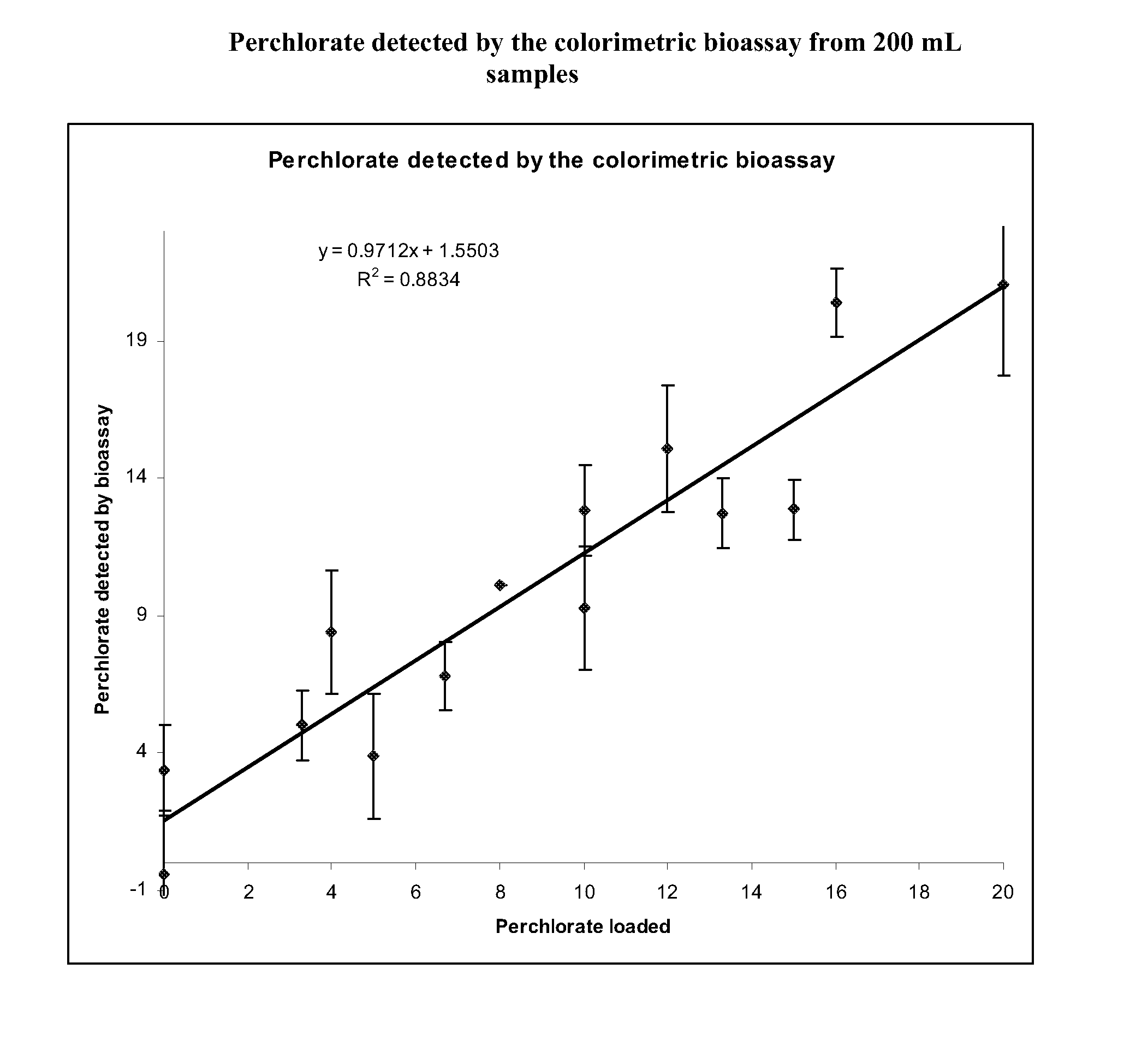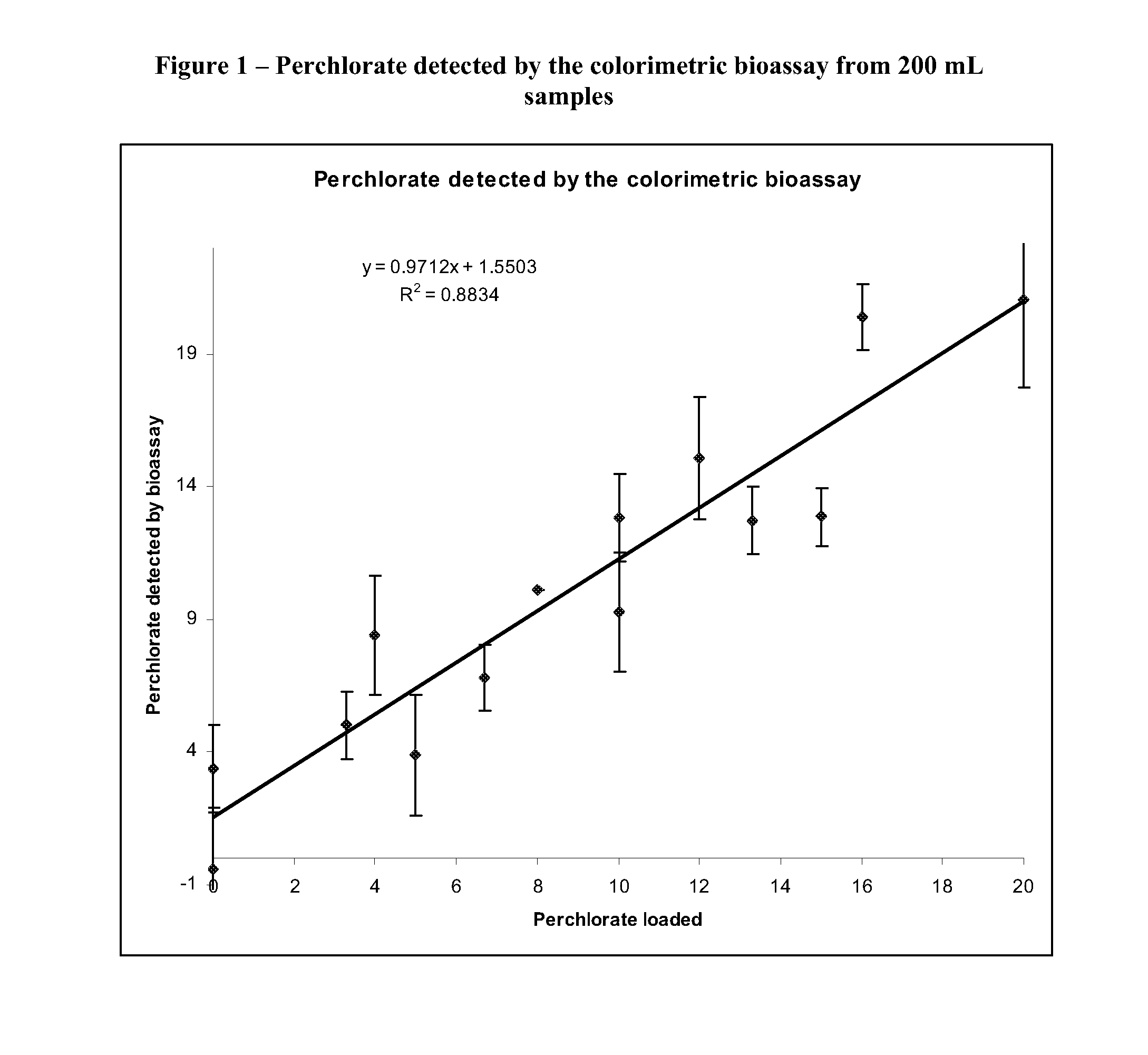Colorimetric bioassay for perchlorate
a bioassay and colorimetric technology, applied in biochemistry apparatus and processes, instruments, library screening, etc., can solve the problems of high cost, time-consuming, and difficult assay, and achieve the effect of improving the detection accuracy and accuracy
- Summary
- Abstract
- Description
- Claims
- Application Information
AI Technical Summary
Benefits of technology
Problems solved by technology
Method used
Image
Examples
example 1
Analyzing Samples Concentrated on the SPE Columns
[0068]Perchlorate concentrations were brought to 0-20 ppb in two hundred milliliter samples of ddH2O. These samples were loaded onto SPE columns that were cleaned with acetone and ddH2O. The SPE columns were also equilibrated with 1 mL of 25 mM DTAB. The samples were pushed through the columns using nitrogen gas pressure (˜10 psi) in a multihead manifold. Following the loading step all residual liquid was pushed through the columns using a 60 mL syringe. Perchlorate was eluted from the column using 2 mL of a 2 M NaCl and 200 mM MOPS (pH 12.5) solution. Following the elution the samples were neutralized by adding 300 μL 1 N HCl. An approximate pH of 7.5-8.0 was determined using pH paper. Following the elution, samples were analyzed in the anaerobic chamber.
[0069]280 μL of sample were incubated with 175 μM PMS and 500 μM NADH. Once the absorbance at 340 nm stabilized (˜10 min) 3 μL of whole cell lysate was added to the sample. The react...
example 2
Purifying Perchlorate from Anionic Contaminants
[0070]As described above, 200 mL samples were loaded onto SPE columns that were preconditioned with decyltrimethylammonium bromide. The 200 mL samples were spiked with the indicated concentrations of perchlorate, as well as the contaminants listed in Table 1.
[0071]
TABLE 1Bioassay determination of perchlorate in samples co-contaminatedwith 100 ppm nitrate or 1 ppm chlorateActualConcentrationddH2O (no co-1 ppm(ppb)contaminants)100 ppm NitrateChlorate0−1.861.09−0.9354.513.763.821010.536.726.381514.3016.3512.212018.9121.8717.95
[0072]It was found experimentally that nitrate could be added to a final concentration of 100 ppm and eluted to a non-interfering concentration with 7.5 mL of 15% acetone and 2.5 mM DTAB. Nitrate was selected as a contaminant of study because it is a common groundwater anion, and was shown previously to interact with perchlorate reductase. Perchlorate concentrations were determined using a standard curve generated usi...
example 3
Determining Perchlorate Concentrations in Contaminated Groundwater Samples
[0074]Four groundwater samples were acquired from a perchlorate-contaminated site in Sacramento, Calif. with approximate contaminations of perchlorate (shown in parentheses by sample identification number). The actual perchlorate concentrations were determined by both ion chromatography and the colorimetric bioassay following a concentration on the SPE columns (with the exception of the sample ID# 4703, which was analyzed following a 10 fold dilution in eluting buffer). In both techniques, perchlorate concentrations were determined using standard curves generated from a purchased perchlorate stock. The results are shown in Table 2.
[0075]
TABLE 2Perchlorate determined from various environmentalgroundwater samples collected from aknown perchlorate-contaminated site in California.St. Dev.Average (ionSample(ion chroma-chroma-AverageSt. DevIdentification#tography)tography)(Bioassay)(Bioassay)7069 (~6 ppb)1.93 ppb0.6...
PUM
| Property | Measurement | Unit |
|---|---|---|
| pH | aaaaa | aaaaa |
| pH | aaaaa | aaaaa |
| path length | aaaaa | aaaaa |
Abstract
Description
Claims
Application Information
 Login to View More
Login to View More - R&D
- Intellectual Property
- Life Sciences
- Materials
- Tech Scout
- Unparalleled Data Quality
- Higher Quality Content
- 60% Fewer Hallucinations
Browse by: Latest US Patents, China's latest patents, Technical Efficacy Thesaurus, Application Domain, Technology Topic, Popular Technical Reports.
© 2025 PatSnap. All rights reserved.Legal|Privacy policy|Modern Slavery Act Transparency Statement|Sitemap|About US| Contact US: help@patsnap.com



